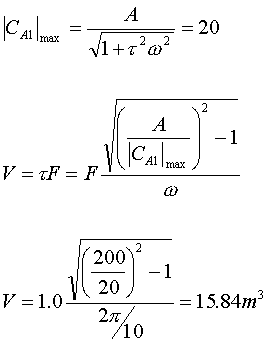
The change in the period of the disturbance resulted in an increase in the required tank volume.
From textbook Example 4.14 it is possible to see how the earlier model of a stirred tank mixer was amended to contain a periodic input rather than a step input in eq. (4.65). This modified differential equation was then solved analytically using Laplace transforms. Some additional algebra was performed to combine terms and produce eq. (4.67). This differential equation is the mathematical model of this system with a periodic input.
Of the two terms in eq. (4.67) only the second is relevant to the behavior of the outlet concentration in response to the periodic input, because frequency response is defined as the "long-time" behavior after initial transients. The first term goes to zero at a long time and is then omitted from the remainder of the calculation.
In this example, the maximum allowable variation in the outlet concentration of the mixer is 20 g/m3. By equating the amplitude term of the differential equation, eq. (4.67), and the maximum deviation in CA1, we can solve for the tank volume.
|
|
The change in the period of the disturbance resulted in an increase in the required tank volume. |